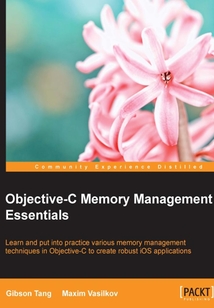舉報 

會員
Objective-C Memory Management Essentials
最新章節:
Index
IfyouarenewtoObjective-CoraveteraniniOSapplicationdevelopment,thisisthebookforyou.Thisbookwillensurethatyoucanactivelylearnthemethodsandconceptsinrelationtomemorymanagementinamoreengagingway.BasicknowledgeofiOSdevelopmentisrequiredforthisbook.
目錄(99章)
倒序
- coverpage
- Objective-C Memory Management Essentials
- Credits
- About the Authors
- About the Reviewers
- www.PacktPub.com
- Support files eBooks discount offers and more
- Preface
- What this book covers
- What you need for this book
- Who this book is for
- Conventions
- Reader feedback
- Customer support
- Chapter 1. Introduction to Objective-C Memory Management
- Why do we need memory management in Objective-C?
- An object's ownership and life cycle
- Ownership of object and reference counting
- What's a memory leak and why pay attention to it?
- Summary
- Chapter 2. Automatic Reference Counting
- What is ARC and how does it work?
- How ARC looks
- Project settings for ARC
- A memory model in Objective-C
- What you need to know about ARC and weak references
- Summary
- Chapter 3. Using Autorelease Pools
- Understanding the autorelease pool mechanism
- Autorelease pool mechanism
- An overview of Apple autoreleased classes
- ARC and autorelease
- Autorelease pool blocks and threads
- Summary
- Chapter 4. Object Creation and Storage
- Creation and initialization of objects
- What is a class?
- Object immutability
- Object mutability
- Inheritance
- Convenience initializers
- An Objective-C programmer's responsibility
- The singleton pattern
- Creating @property
- Creating custom methods
- String formatting
- Summary
- Chapter 5. Managing Your Application Data
- Device memory
- Caching
- SQLite
- Summary
- Chapter 6. Using Core Data for Persistence
- Why use Core Data?
- Understanding Core Data concepts
- Putting it into practice
- Getting into the code
- Saving data into the persistent store
- Deleting data from the persistent store
- Updating data
- Summary
- Chapter 7. Key-value Programming Approaches
- What is key-value coding or KVC?
- The NSKeyValueCoding protocol
- Manual subsets of NSKeyValueCoding behavior
- Associated objects
- Selectors as keys
- Maximum flexibility and handling unusual keys/values
- Key-value observing
- Summary
- Chapter 8. Introduction to Swift
- Welcome to Swift
- Basics of Swift
- Memory management in Swift
- Summary
- Chapter 9. Memory Management and Debugging
- Memory leaks
- Using the debugger and breakpoints
- Collecting data on your app
- Plumbing memory leaks
- Using the LLVM / Clang Static Analyzer
- Summary
- Chapter 10. Tips and Tricks for Memory Management
- Objective-C C and memory management
- Getters and setters
- The property attribute in Objective-C
- Performance guidelines
- Don't overthink about memory management
- When to avoid KVC and KVO
- Summary
- Chapter 11. Features of Xcode 6
- Introducing Xcode 6
- What's new in storyboard
- Debugging in Xcode 6
- What's new in Interface Builder
- Playground for Swift
- Summary
- Index 更新時間:2021-07-23 20:09:30
推薦閱讀
- Docker and Kubernetes for Java Developers
- NumPy Essentials
- 你必須知道的204個Visual C++開發問題
- Learning Unity 2D Game Development by Example
- Node.js:來一打 C++ 擴展
- Mastering Git
- Learning Apache Cassandra
- 深度學習入門:基于Python的理論與實現
- Spark技術內幕:深入解析Spark內核架構設計與實現原理
- Java EE基礎實用教程
- 從零開始學UI設計·基礎篇
- Learn C Programming
- Practical Linux Security Cookbook
- Selenium自動化測試實戰:基于Python
- 梔子貓的奇幻編程之旅:21天探索信息學奧賽C++編程
- Java并發編程深度解析與實戰
- Hadoop實戰
- Java到Kotlin:代碼重構指南
- C語言程序設計
- Erlang編程指南
- PHP動態網站程序設計(第2版)
- LibGDX Cross:Platform Development Blueprints
- Understanding Software
- Mastering Application Development with Force.com
- HTML5技術與移動出版
- Testing Vue.js Components with Jest
- Java應用開發:基礎知識
- Microsoft Tabular Modeling Cookbook
- 國際大學生程序設計競賽例題解(八)
- jQuery開發指南

